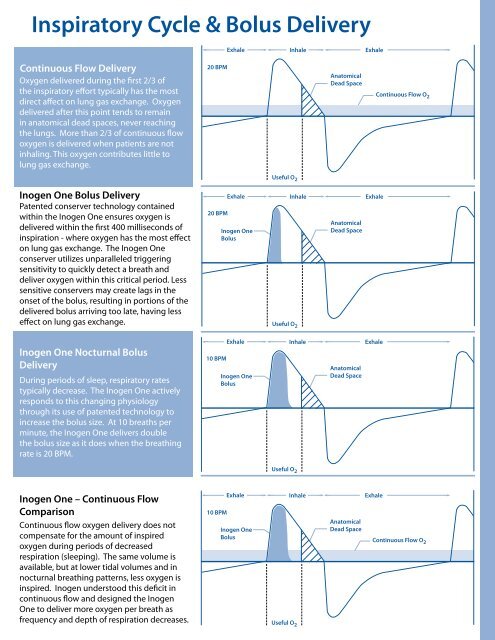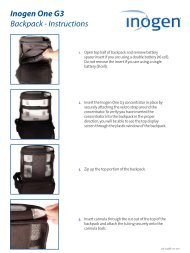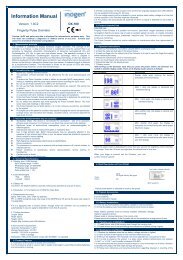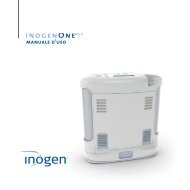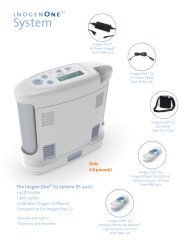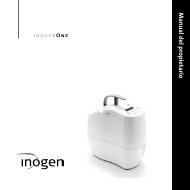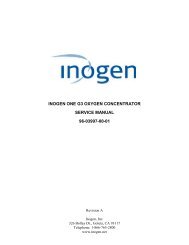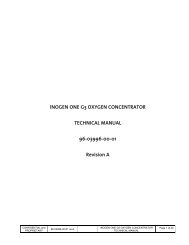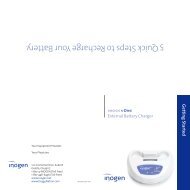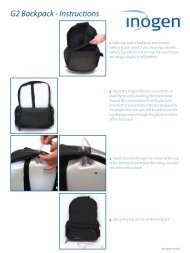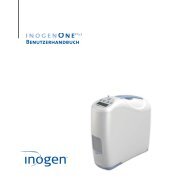Up to 50% of continuous flow oxygen therapy patients ... - Inogen One
Up to 50% of continuous flow oxygen therapy patients ... - Inogen One
Up to 50% of continuous flow oxygen therapy patients ... - Inogen One
You also want an ePaper? Increase the reach of your titles
YUMPU automatically turns print PDFs into web optimized ePapers that Google loves.
Inspira<strong>to</strong>ry Cycle & Bolus Delivery<br />
Exhale Inhale Exhale<br />
Continuous Flow Delivery<br />
Oxygen delivered during the first 2/3 <strong>of</strong><br />
the inspira<strong>to</strong>ry effort typically has the most<br />
direct affect on lung gas exchange. Oxygen<br />
delivered after this point tends <strong>to</strong> remain<br />
in ana<strong>to</strong>mical dead spaces, never reaching<br />
the lungs. More than 2/3 <strong>of</strong> <strong>continuous</strong> <strong>flow</strong><br />
<strong>oxygen</strong> is delivered when <strong>patients</strong> are not<br />
inhaling. This <strong>oxygen</strong> contributes little <strong>to</strong><br />
lung gas exchange.<br />
20 BPM<br />
Ana<strong>to</strong>mical<br />
Dead Space<br />
Useful O 2<br />
Continuous Flow O 2<br />
<strong>Inogen</strong> <strong>One</strong> Bolus Delivery<br />
Patented conserver technology contained<br />
within the <strong>Inogen</strong> <strong>One</strong> ensures <strong>oxygen</strong> is<br />
delivered within the first 400 milliseconds <strong>of</strong><br />
inspiration - where <strong>oxygen</strong> has the most effect<br />
on lung gas exchange. The <strong>Inogen</strong> <strong>One</strong><br />
conserver utilizes unparalleled triggering<br />
sensitivity <strong>to</strong> quickly detect a breath and<br />
deliver <strong>oxygen</strong> within this critical period. Less<br />
sensitive conservers may create lags in the<br />
onset <strong>of</strong> the bolus, resulting in portions <strong>of</strong> the<br />
delivered bolus arriving <strong>to</strong>o late, having less<br />
effect on lung gas exchange.<br />
20 BPM<br />
Exhale Inhale Exhale<br />
<strong>Inogen</strong> <strong>One</strong><br />
Bolus<br />
Useful O 2<br />
Ana<strong>to</strong>mical<br />
Dead Space<br />
<strong>Inogen</strong> <strong>One</strong> Nocturnal Bolus<br />
Delivery<br />
During periods <strong>of</strong> sleep, respira<strong>to</strong>ry rates<br />
typically decrease. The <strong>Inogen</strong> <strong>One</strong> actively<br />
responds <strong>to</strong> this changing physiology<br />
through its use <strong>of</strong> patented technology <strong>to</strong><br />
increase the bolus size. At 10 breaths per<br />
minute, the <strong>Inogen</strong> <strong>One</strong> delivers double<br />
the bolus size as it does when the breathing<br />
rate is 20 BPM.<br />
10 BPM<br />
Exhale Inhale Exhale<br />
<strong>Inogen</strong> <strong>One</strong><br />
Bolus<br />
Ana<strong>to</strong>mical<br />
Dead Space<br />
Useful O 2<br />
<strong>Inogen</strong> <strong>One</strong> – Continuous Flow<br />
Comparison<br />
Continuous <strong>flow</strong> <strong>oxygen</strong> delivery does not<br />
compensate for the amount <strong>of</strong> inspired<br />
<strong>oxygen</strong> during periods <strong>of</strong> decreased<br />
respiration (sleeping). The same volume is<br />
available, but at lower tidal volumes and in<br />
nocturnal breathing patterns, less <strong>oxygen</strong> is<br />
inspired. <strong>Inogen</strong> unders<strong>to</strong>od this deficit in<br />
<strong>continuous</strong> <strong>flow</strong> and designed the <strong>Inogen</strong><br />
<strong>One</strong> <strong>to</strong> deliver more <strong>oxygen</strong> per breath as<br />
frequency and depth <strong>of</strong> respiration decreases.<br />
10 BPM<br />
Exhale Inhale Exhale<br />
<strong>Inogen</strong> <strong>One</strong><br />
Bolus<br />
Useful O 2<br />
Ana<strong>to</strong>mical<br />
Dead Space<br />
Continuous Flow O 2


